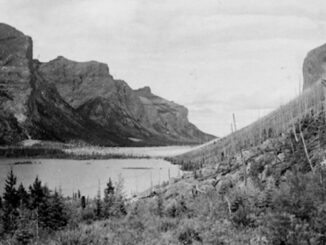As a kid growing up in Saskatchewan I have fond memories of watching thunderstorms rolling across the prairie landscape. Summers were hot and humid, ideal conditions for creating these massive storm cells that you could see from miles away. Incredibly dark skies, hard rain, hail, booming thunder, electricity in the air, and of course the wind. Not all of these storms would result in a tornado, but every once in a while one would touch down. They were equal parts fascinating and terrifying. Now having lived in Alberta for the past 12 years I miss those late afternoons spent in awe of the raw power of nature. Don’t get me wrong, Calgary and surrounding area definitely have some impressive storms in the summer, but our proximity to the Rocky Mountains creates weather patterns that are different than what I experienced back home. It was because of those early memories that I reached out to Ricky Forbes, a professional storm chaser, to see if he’d be interested in sharing a bit about himself and his captivating day-job.
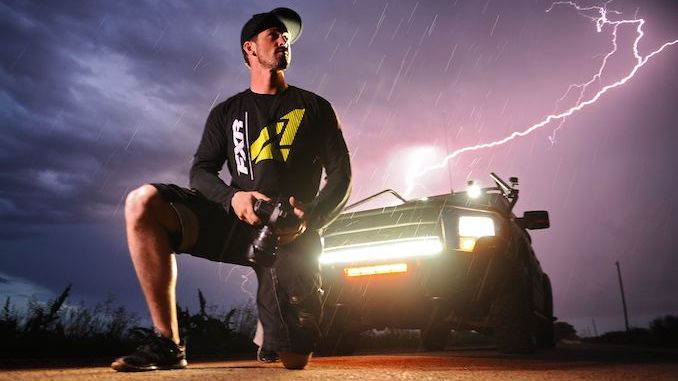
Ricky was also born and raised in Saskatchewan and spent his youth chasing the adrenaline rush of action sports like dirt biking, snowmobiling, mountain biking, and snowboarding. He dabbled for a few years in the business world, but quickly realized his heart was never really in it and his passion for adventure was too strong to be confined to an office. Today he’s the star of ‘Tornado Hunters‘ on Netflix, the host of Woods Canada’s Greatest Explorer, the host of Much Music’s ‘Far and Wide‘, a professional storm chaser, an action sports junkie, has half a million followers on social media, and is co-owner of Blue Moose Media, a digital marketing agency.
It wasn’t all television shows and celebrity status from the start though. There were years of grinding and uncertainty to get where he’s at today. What follows are the highlights of an hour-long conversation with Ricky about life, his pursuit of adventure, and what made him go all-in on chasing some of the biggest storms on the planet.

Calgary Guardian: “How did you get into storm chasing? Did growing up in Saskatchewan, the Land of Living Skies, play a role in your current career path?”
Ricky Forbes: “It wasn’t a career path at all. I’ve always had a passion for the outdoors and adventures. I was chasing all types of adventures and got a bit of a reputation as a thrill seeker. Back in 2012 a colleague of mine, Greg Johnson, called me up and asked me to go storm chasing. I had no idea people even did that. So I went out with him for the first time and when I saw my first tornado I just fell in love. It was absolutely incredible! I started pursuing it as a hobby during my time off. Greg and I were constantly brainstorming ways that we could potentially make a career out of this. We jumped in head first and attacked it from multiple angles; social media, selling photos, speaking gigs, chasing sponsors, basically any avenue we could find to make a little money. After a few years we started doing really well. We were getting the biggest storms and were coming away with pretty incredible photos and video. Eventually we were noticed by a production company out of Toronto that wanted to make a show about chasing tornadoes. That was the break we needed after years of pursuing this dream.”
CG: “Does storm chasing take you across the country or do you typically stick to certain geographical regions?”
RF: “We are a Canadian team so we started on the prairies of Saskatchewan, Manitoba, and Alberta. As we grew we expanded down through Tornado Alley in the USA. The biggest storms are found in this region of Oklahoma, Nebraska, Kansas etc. They have all the right ingredients for impressive storms and most of our work is now in this area of the US.”
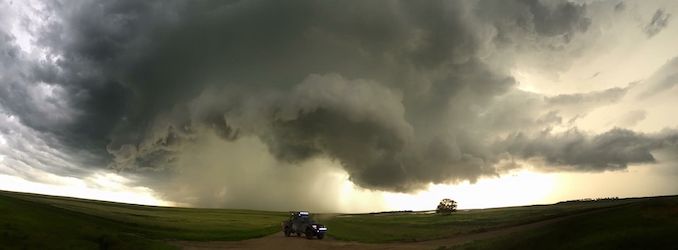
CG: “Storm chasing is obviously inherently dangerous. What are some of the biggest risks associated with your job and how do you mitigate those risks to keep yourself and your team safe?”
RF: “Two of the biggest risks are getting too close to the tornado and having it move where you don’t expect. They can grow and shift and if you’re too close it can become very dangerous. We have some of the best radar available in our truck to track its movement and the knowledge to try and predict where it’s going. Most tornadoes move in a north-easterly fashion so we typically try to stay behind it, out of harm’s way. The other danger is the debris that’s coming out of the tornado. These object can be travelling between 100 and 300km/hour, so it’s wise to keep your distance. Our truck comes equipped with a full roll cage and is wrapped in a Line-X coating, which is twice as thick as you’d find in your typical truck box and acts like a bulletproof coating. However, the windows are not bulletproof so they are very vulnerable. We’ve had to replace multiple windshields lost to hail storms.”
CG: “I’m assuming storm chasing is a seasonal endeavor. When is the typical storm season here in Canada?”
RF: “It takes heat to create storms so here in Canada we’re looking at the spring and summer months. The further south you get the earlier things happen. Storms can occur year-round in the southern states, but we typically won’t head south until mid-March or later. Most of the storm’s power, and its main source of fuel, comes from the hot, humid air of the Gulf of Mexico. This is why storm season starts in the southern USA in later winter/early spring and moves northward as the year goes on. Our biggest months are from April to June in the US and then we’ll find ourselves on the Canadian prairies from June through August.”
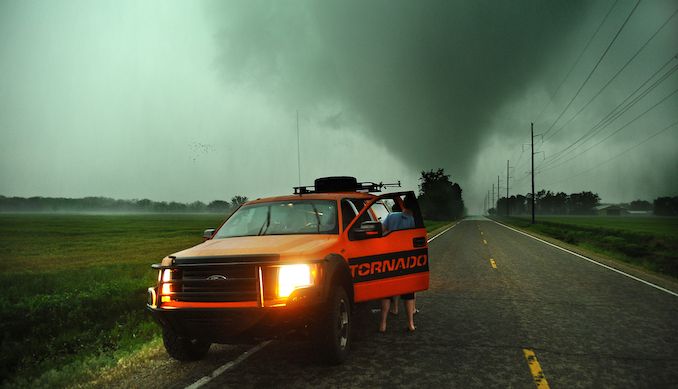
CG: “Some people might assume you’re crazy or just a thrill-seeker for chasing storms. Why do you do it? What do you hope to discover or accomplish by chasing storms?”
RF: “It is an experience unlike anything else! It is absolutely thrilling and feels out of this world. I’d almost compare it to seeing the mountains for the first time. It’s just so much bigger than you are. The storm is a living organism. There is this incredible coloured sky. The air is electric. It’s hot, humid, your hair is standing up. There’s just so much energy in these storms. The clouds form these amazing structures. We use the slang term ‘mother ships’ to describe their unique shapes. We’re out in the middle of nowhere with almost nobody else around. Few people are willing to put in the work required and even fewer are willing to give up everything to chase clouds. There is a lot of luck involved. During the best years you’ll get a tornado or at the very least a storm almost everyday. The worst years though, you’ll go weeks without seeing anything despite having the best tech available. I also like the element of competition. You’re always competing with other teams and yourself. For example, the storm you’re chasing loses energy and falls apart, but the competing team gets a spectacular one. That competition is fun and keeps us on our toes! It’s like we’re seeking out this rare jewel and when they go off, words just can’t describe it. Sometimes they’ll only last 10-20 minutes so they’re quite easy to miss, but other times they’ll last for 3+ hours. Our goal is to capture images to share with the world. The content resonates with all ages due to the connection with nature. We want to tell their story using our passion for photography and videography. We are always striving to perfect our craft and to capture photo and video that’s better than ever before.”
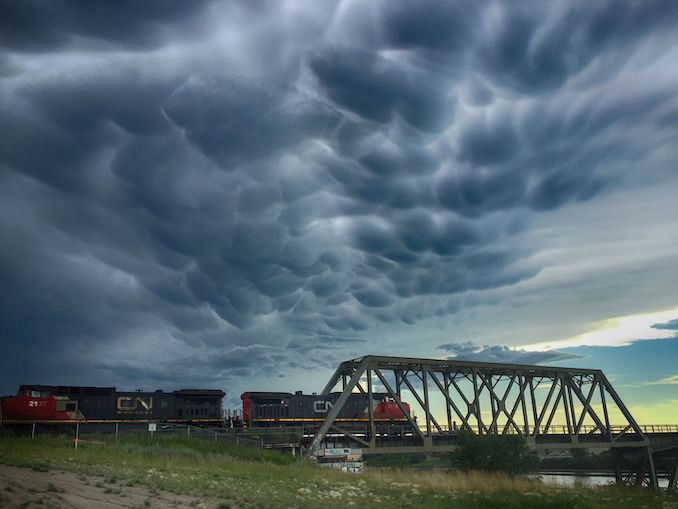
CG: “There is likely no such thing as a typical day at the office for you, but could you walk me through what an average day might look like?”
RF: “During storm season we are constantly on the road. We’re monitoring the radar and developing a loose forecast two weeks out. Within a week we’re watching things a lot closer and then we have to make a decision about what we believe is going to happen, and where. We pack all of our cameras and gear and hit the road. We need two full days to drive down to the southern USA from Saskatchewan, so we take turns behind the wheel and drive straight through, watching radars the whole time. The government has access to the best radar available and will usually publish storm info between midnight and 1:00am. Usually the storms fire off between 2:00 and 4:00pm as they need the day to heat up and gain energy. In a perfect situation we’ll sleep in and prep gear for the afternoon, but most of the time we’re not in the right spot and the storms have shifted so there’ll be lots of driving the next morning. When we arrive at the hot spot we’ll wait for storms to start popping up. Depending on the geographical features nearby, such as valleys or mountain ranges, storms will roll-in almost like waves. We’re typically waiting for the 3rd, 4th, or 5th storm, which will have the most heat, so we’re always keeping a close eye on the radar and are picky about which storm to follow. With safety in mind, we’re also watching the storms that are rolling in behind the one we’re chasing. We’ll play our cards on catching one storm, but the rare time we’ll catch two or three in a row and then we’re on top of the world. Once the storm starts breaking up we’ll pull over and start going through footage and send off the best stuff to our contacts at various media outlets. With storm chasing you have to be the first to the punch to make the news or your stuff won’t be bought and used. After that we’ll spend the evening getting lightning shots, so the days are very long. We might not be back at the hotel until 3:00 or 4:00 in the morning. All the while we’re watching forecasts and if the next day has the potential to be big, but it’s 3 or 4 states away, we’re back in the truck taking turns driving to the next destination. The old saying ‘make hay while the sun shines’ is pretty accurate in our line of work. A good run could last 3 to 5 days and then we’ll go with nothing for a week or more, so it gives us time to rest and recuperate. Then the grind continues.”

CG: “Most people have seen the movie Twister. Is storm chasing anything like the movie depicts, with flying cows and a fierce rivalry between teams?”
RF: “Everything you’ve seen in Twister, with the exception of the love scene, we’ve seen in real life, but the storms are a lot bigger and scarier. Rivalry does happen but there are more teams out there than in the movie. When we first started there were 2 or 3 main competitors, but now there are a lot more due to social media and the fact that tech is cheaper so it’s more accessible to a wider audience. Some days there is a fierce rivalry especially if we show up at the same spot. If this happens we end up cannibalizing each other’s business because we’re capturing the exact same content. When this happens we’ll typically flip a coin to see who gets to stay, which ends up being better for both businesses in the end. There are definitely personality difference between teams, but sometimes it’s just so nice to see somebody in a remote place. Storm chasers are a different breed. You’ll find everything from amateurs to people with master’s degrees in meteorology. You never know what you’re going to get out there.”

CG: “Is there one storm that you’d describe as unforgettable? If so, what made it so impressive?”
RF: “For me, there are three days that really stand out:
- May 31, 2013 in El Reno, Oklahoma. We were too close and got caught on the edge of the tornado. This is the only time it’s happened and believe me, nobody wants that to happen. At that point it doesn’t matter how much knowledge, skill, or tech you have, you’re playing against the odds. It’s just terrifying. We were on the edge of having our ears pop, which means we know we are way too close. We hit the ditch just trying to get out of there. Everything is flying around; farm machinery, hay bales, debris. A farm yard was ripped apart right beside us. Easily our closest call while storm chasing.
- June 16, 2014 outside Pilger, Nebraska. We caught twin tornadoes. Before that moment we’d never even heard of the idea, let alone fantasized about it. We had no idea it could even actually happen. Storms that produce tornadoes are called supercells and are massive spinning beasts. Air is their fuel. If one storm gets too close to another they’ll kill each other because they’ll suck each other’s air. The conditions were perfect as both were able to coexist. It was one of the few times in history that it’s ever been documented. They existed side by side for over an hour. As a storm chaser it’s pretty rare to see two EF4’s a year, maybe ever, let along two side by side. We were also one of the only teams to capture it that day.
- July 27, 2015 near Tilston, Manitoba. This was the biggest tornado we’d ever caught in Canada and one of the biggest in the world that year. It looked like four fingers spinning around and then collided into one massive tornado that lasted for 2.5 hours. Luckily, due to its location, it caused very little damage.

CG: “After browsing your social channels, it becomes quite obvious that there’s a lot more to you than just storms. Your Instagram feed alone is like an outdoor adventurer’s dream. Do you have a favourite activity outside of storm chasing or are you basically a jack of all trades when it comes to adventure?”
RF: “Ohhh boy! It would be between snowmobiling and mountain biking. These are my two favourite sports. With snowmobiling you get to explore mountains and places you just can’t go on foot. On a bike it’s just so peaceful; it’s poetic and gnarly at the same time. You need to absolutely live in the moment to stay safe on a bike. There just aren’t many other experiences like it.”
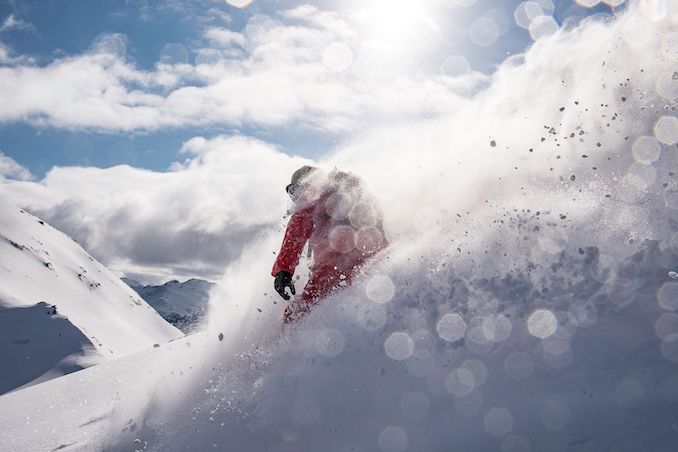
CG: “What advice would you give to anyone looking to get into the profession?”
RF: “It’s the same for storm chasing as anything else in life. Contact someone who’s already doing it and pick their brain. Learn from them. Educate yourself. They’ll offer advice and help you fast track by answering questions and providing guidance. Take a ride along to get some firsthand knowledge. Ask to join a team for a day. Many are happy to show off what they love to do. It’s definitely easier than forging your own path.”
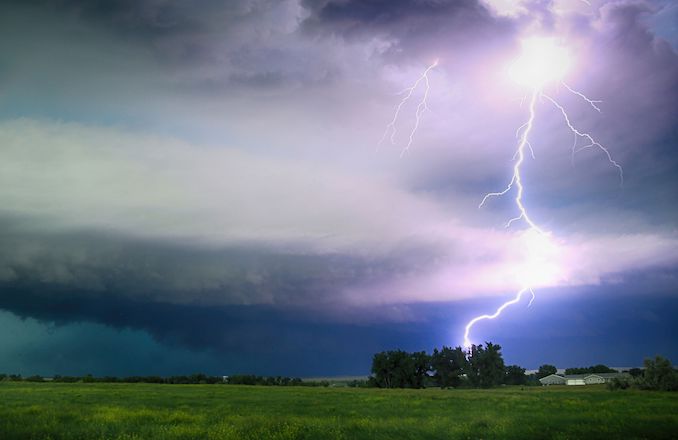
I don’t know if it’s our Saskatchewan roots, our shared passion for gravity sports and photography, or something else entirely, but after chatting with Ricky it was like I found a long-lost friend. I’d like to take this opportunity to thank Ricky for his time and for allowing us a glimpse into his adventurous life. To stay up to date with the latest from Ricky Forbes please follow him on Facebook, Twitter, and Instagram. You can also check-out his website for even more stunning content.
***
About this column:
Wild Jobs is a running series that focuses on people in outdoor-related professions. It provides a brief snapshot of their career and the duties that it entails. Please see my previous post, Wild Jobs Part Fourteen: Mountain Sports Photographer to learn more.



